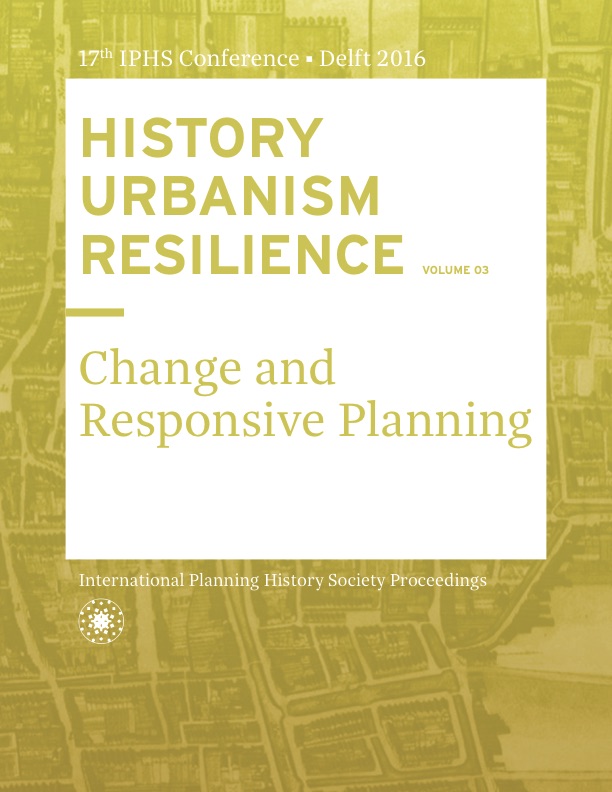CENTRAL SÃO PAULO: THREE APPROACHES, ONE POSSIBILITY
DOI:
https://doi.org/10.7480/iphs.2016.3.1268Abstract
This paper analyzes the past two decades’ initiatives to regenerate the São Paulo city center. The research initially focuses on a period divided into three stages, each marked by a long-term structuring project: Operação Urbana Centro (Operation City Center), launched in 1997; Programa Ação Centro (Action Program for the Center), started in 2002; and Nova Luz, in 2005.Within the context of contemporary cities, downtown areas in large cities in Brazil and around the world are undergoing similar transformations: peripheral growth, metropolitanization, population flight, and changes to the economic profile of downtowns and traditional areas such as historic centers and industrial and port zones. This scenario has prompted several proposals and discussions for urban projects, urban operations and improvement programs for these areas. These intervention projects result from an ideology in which global cities need to appear competitive on the economic stage in order to attract investment. They are models that are able to promote their position using economic change as a path.
In the case of the projects analyzed in Brazil, regardless of municipal management changes the center has always been subject to intervention, due to underused existing infrastructure, to the area’s history or to its important strategic location.
In São Paulo, the noticeable thing about the initiatives that gained strength in the 1990s is the structural differences between the three main projects: from Operação Urbana Centro (a specific law aimed at attracting new activities to the center and raising funds for improvements to the urban environment) to Ação Centro (an improvements and social development program drawn up through financing from the Inter-American Development Bank); and finally, Projeto Nova Luz (which proposes the redesigning of 45 blocks).
This research thus analyzes how the projects have been carried out in contemporary cities, the concept behind interventions in historic centers and the ways in which these municipal government initiatives have been planned and implemented. By seeking elements to promote urban regeneration based on preexisting factors and on local development, this research aims at contributing towards the redrafting of intervention policies in urban centers, especially in a São Paulo characterized by dispersed urbanization and significant market influence.
This paper has been divided into three parts: an assessment of contemporary transformations and urban projects; a review of facts and elements prior to the projects; and a critical analysis of the center and of the three intervention approaches. It concludes with comments on how these approaches complement each other, on the absence of comprehensive policies for the Regeneration of the City Center and on the need for shared and inclusive urban management.
References
Cymbalysta et al., Políticas para o Centro: controle social do financiamento do BID à Prefeitura Municipal de São Paulo. São Paulo: Instituto Pólis, 2008.
Maquiaveli, Janaina. “Passando a limpo: um passeio pelos processos e pelos projetos de revitalização urbana do Meatpacking District, em Nova York, e da Região da Luz, em São Paulo.” EURE (Santiago), September, 2012. Accessed May 09, 2016. http://www.scielo.cl/scielo.php?pid=S0250-71612012000300007&script=sci_arttext.
Roberts, Peter, and Hugh Sykes. Urban Regeneration a Handbook. London: SAGE Publications Ltd, 2000.
Rojas, Eduardo. Volver Al Centro: La Recuperación de áreas urbanas centrales. New York: Banco Interamericano de Desarollo, 2004.
Rolnik, Raquel. São Paulo. São Paulo: Publifolha, 2003.
Somekh, Nadia. “Projetos Urbanos e Estatuto da Cidade: limites e possibilidades”. Vitruvius, 2008. Accessed May 20, 2014. http://www.vitruvius.com.br/revistas/read/arquitextos/09.097/131.
Somekh, Nadia and Candido Malta Campos. A Cidade que não pode parar: Planos Urbanisticos de São Paulo no século XX. São Paulo: Mackpesquisa, 2002.
Somekh, Nadia. “Projetos urbanos/utopias realizáveis: O caso do centro de São Paulo.” In Espaço Urbano e Inclusão Social: A Gestão pública na cidade de São Paulo 2001 – 2004, edited by Ricardo Gaspar, Marco Akerman, and Roberto Garibe. 261-272. São Paulo: Fundação Perseu Abramo, 2006.
Zanchetti, Silvio. “Conservação integrada e planejamento urbano na atualidade.” Paper presented at the 4th meeting SIRCHAL (Seminarios internacionales sobre la revitalization of these historic centers of Latin America and the Caribbean), Salvador, Bahia, May 10, 2000.

